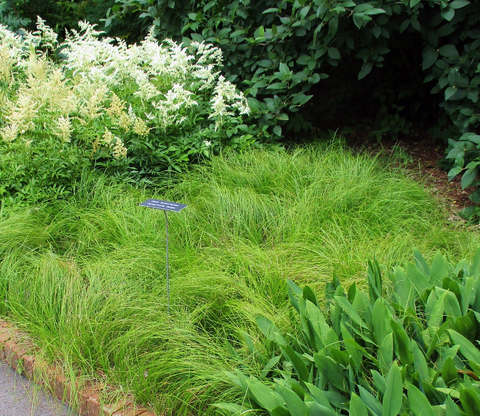As our gardens age, trees grow and produce welcome shade, but shade means a change for what grows under these beautiful trees. A sunny garden and landscape ages into a shade garden.
Here are some recommendations for grasses for shady sites.
Shady favorites: Landscape and ornamental grasses
I know of no tall grasses (4 feet or more) that grow in shade. (Aruncus, goat’s beard, and Thalictrum meadow rue, however, are tall shade-loving perennials).
River oats are native to the Ozark Mountains and the southeastern U.S. and are marginally hardy in Minnesota, but it usually self-seeds to live in shady gardens as a perennial.
Hakone grass is native to the forests of Japan, especially in moist sites.
How to use in the landscape
In establishing these plants, water well in the first year or two, as many shady locations are dry sites with other established plants competing for moisture.
Combine grasses with bold textured hosta, perennial geraniums, lily of the valley, ferns and spring-flowering bulbs (spring bulbs do not like wet feet in the summer) and you can create an interesting garden in the shade.
Ornamental grasses for shade
Below are listed a few lower grasses and sedges that grow well in shade.
Light shade
| Common name | Scientific name | Height |
|---|---|---|
| Porcupine sedge | Carex hystericina* | 2-3½ feet; self- seeds |
| Pennsylvania sedge | Carex pensylvanica* | 6-18 inches; weak rhizomes |
| Bowles golden sedge | Carex elata 'Aurea' | 1-3 feet; prefers wet sites |
| River oats | Chasmanthium latifolium | 2-3½ feet |
| Tufted hairgrass | Deschampsia caespitosa* | 2-4 feet |
| Eastern bottlebrush | Elymus hystrix var. hystrix* | 2-3 feet |
| Hakone grass | Hakonechloa macra | 2-3 feet |
| Hakone grass cultivars | Hakonechloa macra 'Aureola', 'All Gold' | 6-12 inches |
| Woodrush | Luzula sylvatica | flowers 2 feet; basal foliage |
| Golden wood millet | Milium effusum 'Aureum' | 1-2 feet |
Heavy shade
| Common name | Scientific name | Height |
|---|---|---|
| Carnation sedge | Carex flacca | 10-18 inches; aggressive rhizomes |
| Palm sedge | Carex muskingumensis* | 2-3½ feet |
| Long-stalked sedge | Carex pedunculata* | 6-8 inches |
| Pennsylvania sedge | Carex pensylvanica* | 6-18 inches; weak rhizomes |
| River oats | Chasmanthium latifolium | 2-3 ½ feet |
| Tufted hairgrass | Deschampsia caespitosa* | 2-4 feet |
| Woodrush | Luzula sylvatica | flowers 2 feet; basal foliage |
Dry shade - under maple, box elder or spruce trees
| Common name | Scientific name | Height |
|---|---|---|
| Carnation sedge | Carex flacca | 10-18 inches; aggressive rhizomes |
| Pennsylvania sedge | Carex pensylvanica* | 6-18 inches; weak rhizomes |
| Eastern star sedge | Carex radiata* | 6-12 inches |
| Blue fescue | Festuca glauca 'Beyond Blue', 'Cool as Ice', 'Elijah Blue' | 6-12 inches |
| Blue oatgrass | Helictotrichon sempervirens | 18-30 inches |
* Native to shady woods in Minnesota.
Reviewed in 2021


